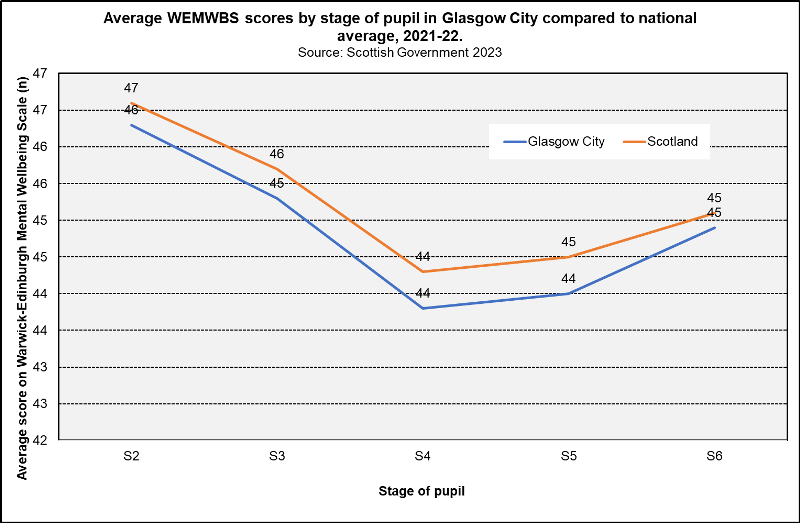Self-reported mental health
This page provides data on the self-reported mental health among primary and secondary pupils in Glasgow City Region collected via the Glasgow Schools Health and Wellbeing Survey 2021-22.
In the Glasgow City Region in 2021, one quarter (26%) of pupils across P5-S6 rated their mental health as 'excellent', less than half (48%) reported it as 'good', and 19% reported it as 'fair'. A small proportion (3%) of pupils reported their mental health as 'poor'. In the same period, 16% of pupils reported they had a physical or mental health condition or illness lasting or expected to last 12 months or more.
Students' mental wellbeing was measured using the Warwick-Edinburgh Mental Wellbeing Scale (WEMWBS) which comprises 14 positively worded statements asking how someone has felt over the last two weeks. Scores can range from 14-70, which higher scores indicating better mental wellbeing. The mean WEMWBS scores for pupils across S2-S6 in Glasgow City Region was 45. One third of pupils (30%) had a score indicating probable depression.
In Glasgow City Region there was little variation in the range of mean WEMWBS scores between younger and older pupils: S2 pupils recorded a mean score of 46 and S6 pupils recorded a mean score of 45. However, there was a difference in scores across the pupils stages, with S4 pupils recording the lowest WEMWBS scores (mean 44). This was also found at a national level.

Pupils across S2-S6 also completed the Strengths and Difficulties Questionnaire (SDQ) which is used to identify emotional and behavioural difficulties in childhood and adolescence. The SDQ comprises of 25 positive and negative statements over five scales assessing: emotional problems, conduct problems, hyperactivity, peer problems, and pro-social. Scores can range from 0-40: scores of 0-14 indicate close to average level of difficulties and scores of 15-17 indicates slightly raised level of difficulties.
The mean SDQ score for Glasgow pupils across S2-S6 was 15, indicating slightly raised level of difficulties. One third (33%) of pupils had a score indicating high/very high level of difficulties.
Notes
National data comes from the Scottish Government Health and Wellbeing Census 2021/22 which is a collated dataset from local authorities who administer the census to children and young people from Primary 5 (P5) to Sixth Year (S6), with age-appropriate questions relevent to each pupil's stage. Data is not weighted to population totals but are linked to Pupil Census to provide characteristics. In the 2021-22 census, 16 local authorities collected data from 51,318 pupils.
Data for Glasgow City Region comes from the Glasgow Schools Health and Wellbeing Survey 2021-22.
This page was updated in May 2024.
